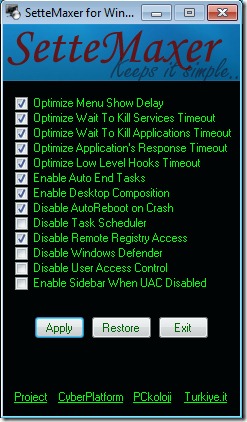We have seen a lot of optimization and tweaking tips and tricks about Windows XP as it has been the most popular Windows so far. People are still used to that decent styled Windows which was much stable than its ancestors. But now Windows 7 is starting to catch everyone’s attention as it seems to be far better than Windows Vista and stable too.
There are some registry tweaks in every Windows which can enhance the performance of Windows like optimizing the Menu show delay, optimizing wait to kill apps timeout etc. With Windows 7 Optimizer, one can avoid touching the registry and a lot of properties can be optimized within Windows 7 Optimizer app. Here are some of the features of Windows 7 Optimizer.

Features of Windows 7 Optimizer
Here are some of the notable features of Windows 7 Optimizer.
Optimize Menu Show Delay:
Sets delay value of menus to 0. The default value is 400ms. I’m used to the default delay so I don’t recommend this option but it’s always up to you when you want your context menus to open.
Optimize Wait to Kill Services Timeout:
Sets its value to 1000ms in order to shorten shutdown/restart duration.
Optimize Wait to Kill Applications Timeout:
Sets its value to 1000ms in order to shorten shutdown/restart duration. This is especially useful when you have a lot of applications open and like me, you’re used to shutdown your system immediately. Enabling this option will cause all the open applications to close almost immediately when restarting or shutting down.
Optimize Application Response Timeout:
Shorten Application Hung Timeout when an application is not responding in order to restart or end it faster. Optimizing application response timeout can be optimized according to ones needs and should be used with care.
Enable Auto End Tasks:
Enables closing the applications all together when shutdown/logoff/restart signal has been sent. This is a very useful tweak especially useful for systems shared by multiple people.
Disable AutoReboot on Crash:
Disables AutoReboot feature on Crashes, It may be possible to carry on the work if the problem is not stopping windows. This option is useful for diagnostics purposes as the system will not automatically restart if Windows encounters any critical error like BSOD.
Disable Task Scheduler:
Disables Task Scheduler. I usually us task scheduler for my backup processes so I don’t disable task scheduler. Task Scheduler should be disabled especially when playing a CPU intensive game as it needs a lot of resources and task scheduler consumes quite a few of them.
Disable Windows Defender:
Disables Windows Defender. If you have a complete internet security solution installed on your system, then you should disable Windows Defender as it only serves as a resource hog. If you don’t have an internet security suite, then disabling Windows Defender will cause low security levels.
Disable User Access Control:
Disables UAC as configuring it to level 0. it will increase the system performance and probably compatibility of older applications while launching them as disabling default security option, will decrease security level.
Download Windows 7 Optimizer
Windows 7 Optimizer can be downloaded from the following location:
[download id=”243″]